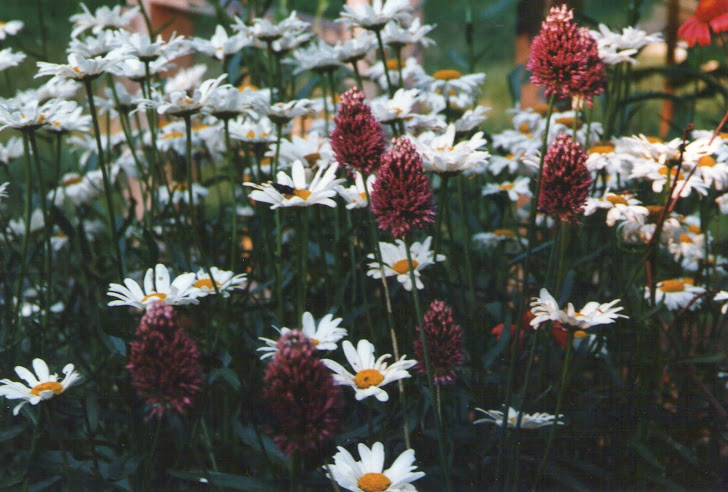Last week's post attracted some interest in wildlife habitats and beneficial bugs. As luck would have it the latest issue of Mother Earth News (April/May 2012) has a great article on attracting beneficial insects (predators is what they are, but that sounds gruesome) to your garden. Did you know that some plants have the ability to produce and release a chemical signal when they are being munched on by the bad bugs? This lets the good guys know where to find a meal. I never cease to be amazed by how smart plants are...like the weeds that choose to grow right around cultivated plants that look an awful lot like them. The article describes the Top 10 Beneficial Bugs (from Braconid Wasps to Trichogramma Mini-Wasps), tells what the larvae and adults eat, and the best plants to attract them. You can't see it in the photo above, but when I took this picture, there were hover flies on the daisies and the alliums were covered in beneficial wasps. (I know they were the non-stinging beneficial wasps because I've been stung by the other kind... Very Mean Bugs. These ones were only interested in nectar.) Plants in the daisy family (cosmos, aster and yarrow are the number one good bug favorites. The carrot family (parsley, dill, fennel and cilantro) come in second. Alyssum made the list to my delight. I had read years ago that alyssum is one of the best plants to attract beneficial insects because the leaves contain nectar as well as the flowers. I plant them every year. It flowers from Spring to frost, is very easy to grow from seed and will often reseed. (Free Plants!) It's a lovely low border plant for around your vegetable or herb garden.
 Purple coneflowers (members of the daisy family) attract a variety of benefical insects. Many of the insects you want to attract are predators in the larval stage and pollinators, in search of nectar and pollen, as adults.
Purple coneflowers (members of the daisy family) attract a variety of benefical insects. Many of the insects you want to attract are predators in the larval stage and pollinators, in search of nectar and pollen, as adults.A note about butterflies. Yes, butterfly larvae do eat your plants. But the adults also pollinate and both serve as very important parts of the food chain, feeding birds, reptiles and amphibians. Many species are endangered and many are not as plentiful as they were just years ago. It would be a crime to lose such beautiful creatures. So let some wild violets grow in your lawn to feed the fritillary larvae. Plant a little extra dill, parsley, or fennel. You won't miss it and you can have swallowtails in your garden.
One bit of information surprised me. I have read many times that in order to encourage diversity and provide a habitat for beneficial wildlife, the back of your garden should be left a little wild, (ie. let some weeds grow). But it has been found that these areas are habitats for insect pests as well. Well-tended areas, called hedgerows, of flowers, grasses, shrubs and trees (with a healthy dose of natives in the mix) attract fewer pests and more beneficials to your nearby crops and vegetable gardens. Something to think about.
HAPPY GARDENING!
For more information: www.MotherEarthNews.com/Beneficial-Bugs
www.nativeplants.msu.edu



Hi Carol,
ReplyDeleteReading your blog from Georgetown, Bahamas where it's 80+ degrees with lovely trade winds. Hoping that my veggie starts, left in the care of a friend, are nearly ready to go into the cold frame when I get home.
Hey, an idea for you. Being the bilingual person you are, how about doing one of your posts each month in Spanish? There is an organization in Seattle called Plant Amnesty that has started offering pruning classes in Spanish....what'dya tink? (that's Bahamian)
Sharon